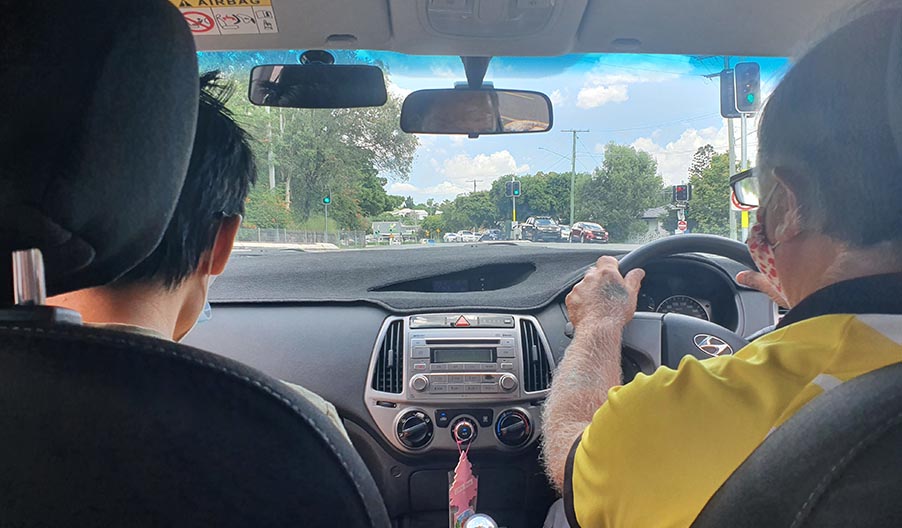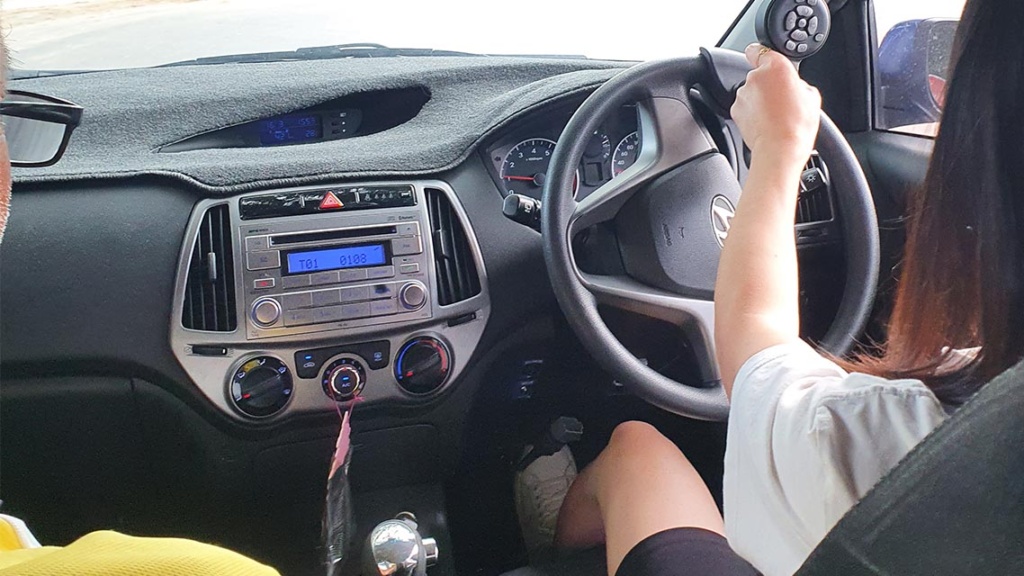I am so grateful I have the pleasure of working with so many wonderful young people who are so motivated to learn to drive, excited about driving, and engaged in our “Get Driving” therapy sessions.
Every Wednesday at the moment I run clinic-based therapy sessions working with young people who are on the path of learning to drive. The “Get Driving” therapy sessions generally are designed to support learner drivers and returning drivers with developing underlying motor, visual and processing skills necessary for driving. Often we work through these sessions to develop skills, to prepare someone for specialised driving lessons with a driving instructor.

The sessions are one-on-one sessions that go for an hour and half, with a combination of activities that are completed in the clinic and out on the road with the client as a passenger in the car.
A session will typically look like this:
- Motor coordination activity e.g. catch and throw, to get the brain fired up and coordinate eye and body movements
- Speed of processing and visual search activity e.g. road sign flash cards, to work on reaction times, visual scanning and processing
- Driving task e.g. identifying the meaning of road signs
- Drive Focus practice
- Then we get in the car, and level up passenger activities – each part of the driving task is broken down where we build these skills individually and then integrate them. We love getting to hazard management and problem solving – and navigating to places like McDonalds.
Please see this link here to get a handout which explains a bit more about what the Get Driving sessions involve.
This week was such a great reminder to me how privileged I am to be a part of this learning to drive process with young people. Each young person who walked into the clinic came in with a smile on their face, excited to tell me about the work they’d been doing at home to practice and develop their readiness for driving skills. They were all eager to engage in the session, actively asking questions and reflecting on their learnings. I’ve seen such growth in these young people, and it’s so exciting to me to be actively seeing and being a part of this journey with them.
Clients who do well with this program are:
- Committed, motivated, and practice at home
- Come to sessions prepared and try really hard
- Work together with the OT and are appreciative of all the support and advice
Just last month I heard back from a client who had previously gone through this “Get Driving” support program with me, and then specialised driving lessons, and has now successfully gained her provisional license. Go Tara! What an achievement! We are so proud of you and wish you all the best with your driving career. Please drive safely and remember everything you’ve learned through this program!
If you would like more information about the potential to drive assessment approach, Get Driving supports or other services we provide you can check out our website!
It is professional consensus in the OT Driving Assessor community that the training, skill and experience of driving instructors is not equal, despite what they may advertise. Although standard driving instructors may advertise that they have worked with individuals with Autism in the past, this does not mean that they have undergone relevant training or possess the knowledge, skills and expertise to work with the Autism, Attention Deficit Hyperactivity Disorder (ADHD) and intellectual impairment (II) population.

Problems encountered with driving instructors who do not hold additional qualifications:
It has been our experience that standard driving instructors may have a basic understanding of Autism, ADHD and intellectual impairment/executive functioning difficulties, however their day-to-day skill is working with neuro-typical students and they have less understanding of the cognitive, sensory, visual and information processing challenges faced by individuals with these diagnoses.
- They are less able to identify skill deficits specific to neurodivergent learners and plan a remediation program to target and develop these skill areas.
- Learning to drive is a highly verbal and non-verbal process and it’s essential that the driving instructor can adapt their teaching and communication style to meet the communication needs of the individual with Autism/ADHD/II. Neurotypical teens will learn to drive by verbal repetition, but this does not work for learners with Autism/ADHD – where they have challenges with verbal/auditory processing and literally often have no idea what the driving instructor is saying – “in one ear and straight out the other”.
- A consequence of a neurotypical driving instructor teaching style of constant verbalisation and commentary (in an overloaded way) – is that we don’t know if the learner driver is actually able to recognise critical items and plan themselves. This has significant safety implications – the client may pass the test, especially if they have been practicing the TMR routes with the instructor, however they may lack the ability to recognise hazards and plan and problem solve effectively. I have seen this first hand in a client:
- Mr M: 3 weeks prior to his test, an on-road review with a regular driving instructor indicated that the instructor was still providing constant verbal commentary – so I didn’t know what the client was seeing/planning for himself, and then when I asked the instructor to be quiet, the learner driver had these problems:
- did NOT plan a lane change safely
- was frazzled with a red light ahead, did not see a merging lane or complete that lane change safely, and needed prompting to notice signs at a slip lane turn. The safety implications are huge and we cannot afford to be putting our teens in this situation.
- It has been our experience that individuals who participate in standard lessons with instructors who are not skilled in tailoring communication and lessons to their needs can lead to reduce understanding of what is being asked of them, reduced generalisation of skills, reduced self-esteem and increased anxiety. This may also lead to young people who may be capable of learning to drive, to be too scared to continue.
- It is of our opinion, that instructors who are not on this list above and not known to or engaging with the driving OT community, most likely lack the skills required to work with these populations effectively.

Some other examples include:
- Mr D.A:
- He had more than 20 lessons in a regional town before moving to an island in the Brisbane bayside area and having 10 lessons with a driving instructor on the island,
- He then had at an on-road assessment with OTDA and specialised driving instructor and was assessed to not have the fundamentals of observation and planning or tactical skills for driving in traffic, with additional lessons recommended to be able to optimise his chances of being successful with achieving his goal.
- Mr A.R:
- after more than 20 hours self-funded lessons with a driving instructor (advertising as experienced with working with clients with autism), had an OT “potential to drive” assessment identifying ongoing issues with observation and planning.
- He was recommended to have a specialised driving training program (20 lessons) through his NDIS plan;
- he elected to continue lessons with the previous instructor and at an on-road re-assessment with OTDA and specialised driving instructor, still was not identifying critical items, having errors with speed control and overall planning and judgement, including driving instructor intervening on the brake when the learner driver did not react to a gardener standing/raking in the middle of the road.
- This young man continued lessons with an instructor from the list below, who worked with him to address his gaps in driving performance, and then he was successful in obtaining his Provisional licence.
- A parent report: driving instructor “yelled” at their learner driver and caused harm to confidence and skills with progressing.
- Our own experiencing working with a driving instructor new to the OT driving assessment space (and self-reporting that he is experienced with working with teens with autism):
- Required significant additional direction and feedback and training sessions to modify his usual approach (targeted at neurotypical drivers / learners with high functioning autism who do not required NDIS support).
- Our own experiencing working with a driving instructor new to the OT driving assessment space (and self-reporting that he is experienced with working with teens with autism):

Our experience in the industry
Driving Well Occupational Therapy has been a leader in this space for five years:
- Director Jenny has been on the committee / convenor of the OT Australia QLD Driving Interest Group for five years
- Driving Well facilitated Dr Miriam Monahan to deliver the “potential to drive” approach to assessments through nine zoom workshops in 2020 and 2021, to approximately 200 OT driver assessors and specialised driving instructors across the country
- Driving Well won the 2021 Australian Road Safety Award for the project “Bringing the Drive Focus app to Australia” – which included the work with the “potential to drive” workshops.
- Jenny won the inaugural OT Australia “Oration” award in 2024, for clinical innovation and contribution to clients and the profession, and was keynote speaker at the OT Exchange conference, in June 2024.

Consensus criteria to be a Specialised Driving Instructor
For a driving instructor to be considered as a qualified ‘Specialised Driving Instructor’ by the OT Driving Assessor community throughout Australia, they must meet the following criteria:
- regular and ongoing experience working with an OT driver assessor and the wider rehabilitation team (GPs, specialists, allied health) with individuals with cognitive, visual and physical disabilities. This is a skill that takes years and years to develop.
- Active engagement with the state wide OT Australia Driving Interest Groups, to keep up-to-date with current practices, industry changes and challenges, and ongoing education.
- Very strongly encouraged: successful completion of the Driver Assessment and Rehabilitation course for Driving Instructors, run by the Institute of Driver Health.
- This course provides advanced training in assessment, treatment planning and teaching strategies for driving instructors who wish to specialise in rehabilitation of drivers with cognitive, physical, psychological or visual conditions including disabilities such as ASD, ADHD and intellectual disability.
- Strongly encouraged: successful completion of the “Potential to Drive” 2 part workshop run by Dr Miriam Monahan.
- The course covers the information processing challenges and learning needs of individuals with ASD and/or executive function disorders and how to approach assessment and treatment planning to maximise skill acquisition and optimise driving outcomes.
- For new instructors coming into the disability industry: Strongly encouraged: successful completion of the Certificate in Specialist Driving Instruction – training package with Micheal Maynard, Specialised driving instructor.
List of specialised driving instructors meeting these criteria in the Brisbane area:
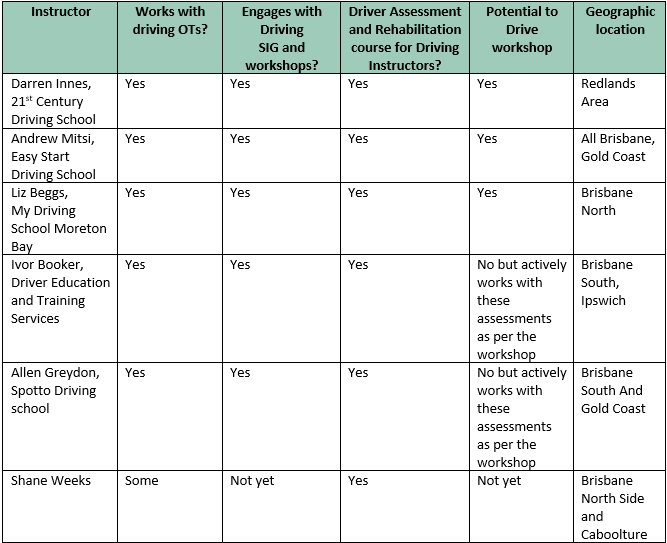
So what?
Bottom line, is that regular driving instructors are likely to be ineffective in teaching in the way that neurodivergent brains will cope and understand, and are likely to waste time and money.
The better approach, is to work with a specialised driving instructor from the start; this is likely to be:
- more effective and SAFE
- be faster, and
- be the most efficient use of funding resources.
I saw a client recently who had been involved in a car accident, let’s call him Chris. He has autism and anxiety. Chris had worked his way to his green Ps through sheer determination. His mum doesn’t drive, so he’d arranged over 100 standard driving lessons himself to learn to drive and gain his 100 hours. He had no input from any health professionals, and didn’t know that he should. He said he managed to pass his practical driving test on the first go and didn’t think he had any challenges with his driving, although noted often people beeped at him for driving too slowly.

Chris said at the time of the accident, he was a delivery driver and felt really stressed by needing to make the delivery within a set timeframe and his workplace tracking his location. He said he was driving at night, stressed about making the delivery, trying to navigate to the location using maps; and whilst driving up a hill, he ran into the back of another car. Chris said he’d been anxious, overwhelmed and distracted.
Chris’s story had me thinking… Could this have been prevented if he had been referred to a driver trained OT earlier in his driving journey? Of course, we all get stressed, anxious and overwhelmed sometimes. Mistakes do happen. But if Chris had been involved in a Potential to Drive assessment before learning to drive, he could have been taught strategies to reduce this risk. He could have been taught strategies to recognise when he’s starting to feel overwhelmed, and how to manage it when he is. He could have been taught critical items to look out for and how to prioritise these. He could have been taught planning, problem solving, and judgement skills in a safe space, so that maybe navigating to a new place wouldn’t have been as stressful.
In the potential to drive approach, we explore a person’s individual needs and create a specialized driver training plan which can include therapy, specialized lessons, and home practice to help Learner drivers get on the road safely.
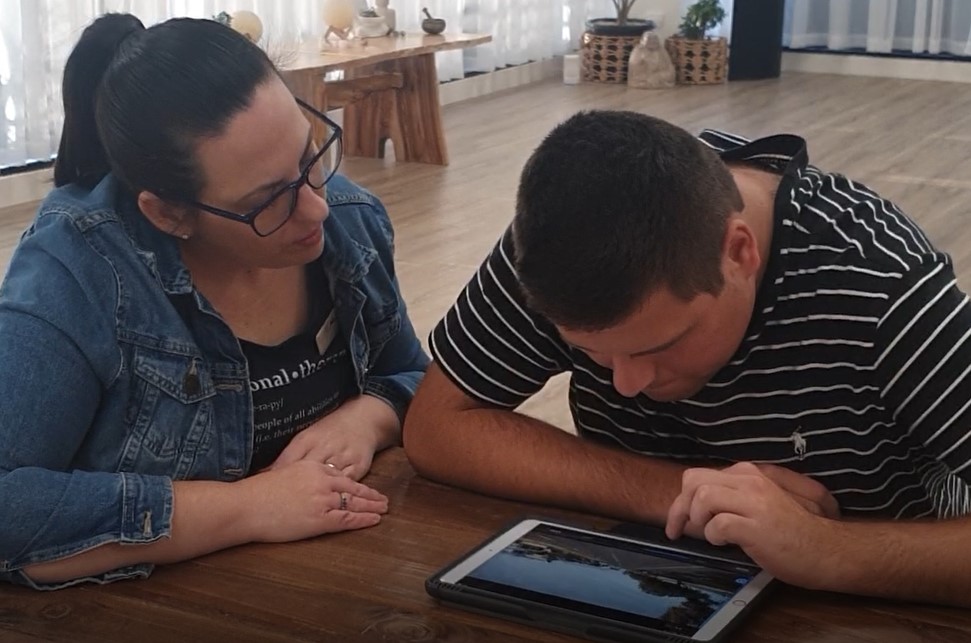
If you or someone you know comes to mind when reading this, please reach out to Driving Well team and we can chat through the process.
I was absolutely thrilled to be the Inaugural recipient of the OT Australia “Oration” award – for a clinician who has been innovative in their work and significantly contributed to the profession of occupational therapy across Australia. The award involved providing a keynote address at the OT Exchange conference, which was held in Perth in June 2024.
We actually have a recording of the keynote address available through the Drive-Able podcast!
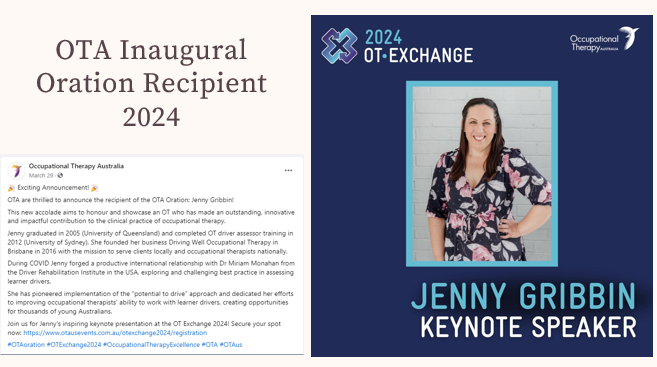
Applying for the award
The application process for the award included writing a personal statement, which I am going to share with you here, as it beautifully sums up my story about how I came to be working and teaching OTs in this Potential to Drive approach.
“In 2019 I advised a 22 year old woman that despite her efforts, she would likely never drive because the challenges of her disability were too severe. She was devastated. It was an awful conversation and I thought “there has to be a better way” to assess and support clients with neurodivergence and psychosocial disabilities wanting to learn to drive.
My curiosity and drive for improvement lead me to finding Dr Monahan in 2020, and with her guidance I pioneered implementation of the “Potential to Drive” approach in Australia. More than 160 driver-trained OTs and rehabilitation driving instructors have attended more than seven workshops transforming clinical practice across the country.
I also collaborated with Dr Monahan to adapt the ‘Drive Focus’ app and bring it to Australia, to date supporting hundreds of young Australians with a disability with their driving goal. I took a leap to then facilitate Drive Focus’ worldwide OT conference debut at OT Exchange in Melbourne 2022 and featured live on the Communities of Practice Facebook group, bringing the app to the attention of thousands of non-driver and driver trained occupational therapists. My work was recognised nationally winning the Australian Road Safety Foundation awards in 2021 and Finalist at Australian Disability Services Awards in 2022.
Innovation never ends: I have also developed a driving therapy program, online toolkit and webinars to support OTs and families. I’m sought after for clinical supervision, inservices, OTA Hot Topic and podcasts, and was recently featured in ABC news stories highlighting updates in licencing guidelines for autism and driving.
My contribution has indeed been outstanding and impactful to the practice of occupational therapy: Australia’s OTs are better prepared to address the question of potential to drive because of my curiosity, leadership and innovation.”
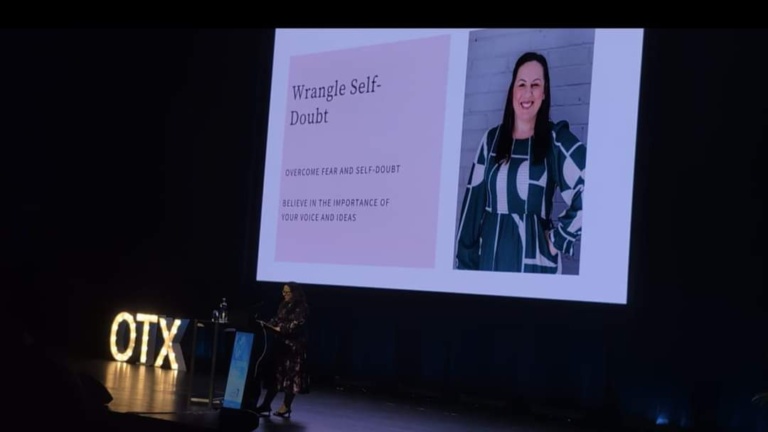
Dr Miriam Monahan
Perhaps the luckiest moment of my career was at the start of COVID, when I discovered Dr Miriam Monahan (OT driver assessor / driving instructor / researcher / lecturer / Drive Focus app developer in the USA) in a US news story online, googled her, reached out through her Drive Focus website, and was on a zoom with her within about 48 hours… our collaboration has led to running the potential to drive training all across Australia, with almost 200 OTDAs and driving instructors having now completed the training and implementing this approach into their practice.
Dr Monahan is an experienced presenter – I have had the pleasure of facilitating nine potential to drive workshops plus other webinars with her, and was ever in awe about her knowledge and how generously she shared her learnings.

Because of these neurological changes and reduced connectivity within the brain, when compared with neuro-typical teens/youth, research has found that learning to drive with autism has common challenges such as[i]:
- It is estimated that approximately 62% of the American population with ASD have high functioning ASD, more than half will pursue learning to drive, and one in three teens with ASD will become licenced drivers[ii].
- Learner drivers require three times longer to learn to drive
- Driving habits are typically that they drive less, and tend to drive more in the local area to defined routes and destinations
Autism characteristics that may impact driving include:
- reduced motor coordination: coordination of limbs for physical control (steering, braking, accelerating), and visual motor integration
- social challenges: literal interpretation of things, interpreting non-verbal cues eg lights, tailgaters, intentions of other drivers when changing lanes etc
- executive functions: often not able to see the big picture and overall understanding of traffic flow through intersections; problem solving; planning ahead; mental flexibility; divided attention
- visual search skills: “look but do not see”, focusing on the horizon versus scanning near and far, take longer to find critical information, experience cognitive overload
- Anxiety is a very common disorder associated with ASD; learner drivers found anxiety to be a barrier for learning to drive[iii]
The workshops
We aren’t giving away all the secrets in this blog post! The workshop will provide you a deeper dive into understanding the research that has been completed with driving and autism and other conditions (there is a lot that is now known). This will help you to understand how features and challenges of a person’s diagnosis may impact them, and how to best support them.
Models underpinning Potential to Drive approach
- Research evidence
- Michon’s model of driving performance – operational, tactical and strategic skills, and looking for evidence of these abilities in the young person’s lifeskills.
- Information Processing Model for driving: Vision and visual search -> information processing/decision -> execute a motor action
- Decision tree for the potential to drive assessment
The workshops
The upcoming potential to drive assessment workshop and implementation workshop, will support you as a driver trained OT to be able to understand these models, and help you to apply them during your assessments with your clients.
Potential to Drive assessment – overview
Dr Monahan has pulled all the research together and outlines an approach to enable OT driver assessors to set-up the assessment environment to minimize anxiety, optimize chance of success, provide a positive experience, and enable best clinical reasoning and decision making about “potential to learn to drive”.[iv]
Clinical assessment:
Clinical assessment is similar to the standard OT driving assessment approach, however will include assessment of visual motor integration, intelligence (where applicable) and an introduction to the “critical items” concept – the critical things we need to pay attention to as a driver.
The workshops
The potential to drive workshops will go through what assessment tools to use and common features/challenges, and clinical reasoning of the outcomes in helping you to make a decision about the outcome of the assessment.
Lifeskills review:
Parent/support worker is asked to complete a lifeskills questionnaire, to look for evidence of operational, tactical and strategic skills.
Where the young person is doing things independently in the community such as catching public transport, organizing themselves for school or a part-time job, doing household tasks such as cooking and washing, and being able to be out in the community, they are showing evidence of tactical and strategic skills which provides a solid foundation for driving.
Where a young person is completely reliant on others and unable to do basic tasks, be a pedestrian and be alone in the community (or even at home), they are not showing sufficient tactical and strategic skills for driving at the moment. Some may benefit from working on these skills with their community OT and waiting until they are a little older and more mature, to re-visit driving then; others will never have the skills for driving and are best supported to learn some community independence
The “$5 test” is a suitable indicator for readiness to drive:
Young person needs to be able to be given a $5 note and told to cross the street to go to the local shop and purchase a loaf of Tiptop multi-grain bread. At the store, they are out of this brand and the person needs to make a reasonable substitution (eg another brand of multi-grain), purchase at the check-out, make change, and return with the bread and change.
If a person cannot independently complete this task, it is likely that they are not ready for learning to drive.
The workshops
You will receive a “Lifeskills checklist” which will help you/your client/parent to rate the client’s current level of performance in a broad range of lifeskills, to help identify readiness to pursue learning to drive. And guess what – there is a brand new electronic version available, making reporting writing so easy!
Passenger activities:
Applying the research, it makes sense that a new learner driver with autism will likely become cognitively overloaded, overwhelmed and anxious, when placed immediately behind-the-wheel. It is too much to expect them to be able to learn to operate the steering wheel, indicators, follow instructions, look at where the car is in space, start to learn driving procedures…. all in a verbal/auditory learning context (when they are visual learners!).
Dr Monahan recommended that to best assess potential to learn to drive, that a series of ‘Passenger activities’ are completed – the specialised driving instructor would be driving their dual-controlled car, young person in the front passenger seat, OT driver assessor and main parent or support worker in the back seat of the car.
The passenger activities look at various components of the driving task ONE-AT-A-TIME in a structured / semi-standardised manner and provides valuable information about the young person’s ability to complete each of these tasks.
Breaking down the underlying tasks required for driving provides the OT Driver Assessor a much better look at the Participant’s ability, without putting them under cognitive overload or too much anxiety. This method also enables assessment of potential to learn, when the young person is a pre-learner and is interested to see if it is worthwhile / feasible for them to pursue obtaining their Learner’s permit.
The workshops will explain:
- What the four passenger activities are
- How to complete them
- How to rate the client’s performance in these
- Use case studies to demonstrate these
- Develop clinical reasoning skills
Behind-the-wheel
For learner drivers, I usually include a short behind-the-wheel assessment – even if it is the first time, we are able to gauge ability to follow instructions, ability to put a few things together (steering, scanning, following procedures, problem solving and ability to make little improvements).
Decision / outcome of assessment
The decision tree provides a framework for pulling all of your results together, to be able to make a recommendation about your client’s potential to continue with learning to drive. There are four possible outcomes:
- Ready now without need for additional supports (mainstream approach)
- Ready now but due to challenges from disability needs specialized support (this likely includes a specialised driving instructor and driving therapy with OTDA, as well as input from general OT, and other AHPs, and family/support workers).
- Not ready for driving yet: needs to work on all pre-driving skills and try again in the future
- Not for driving: challenges from the disability are severe and they need support to develop community mobility independence.
The workshops
The assessment and implementation workshops will help you to develop clinical reasoning skills to work out where your client sits on this decision tree, and make recommendations to the client and family.
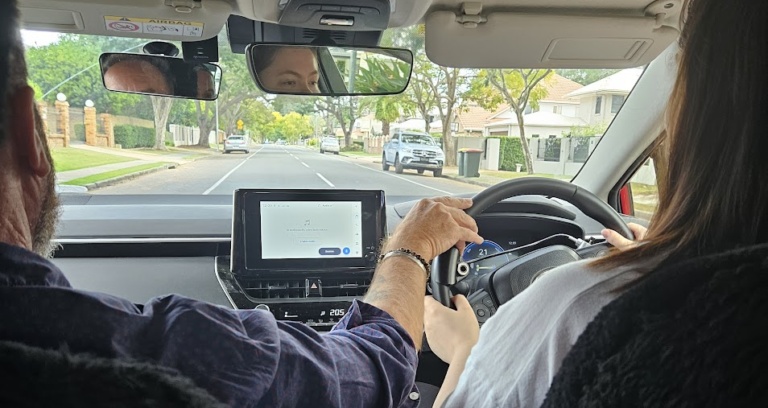
Call to action
If you are an OT driver assessor or specialised driving instructor working the disability learner driver space, and you haven’t done this training before, then you need this training!
We would love you to join us, and we would love to support you with your learning as you implement this approach into your practice, and provide the best support that you can for your clients.
Online Potential to Drive assessment workshop
Details: Wednesday 30th October AND Friday 1st November, 2024, 9am – 1pm BOTH days.
It will not be recorded!
Register here: https://www.trybooking.com/CPOTT
Sydney – in person – Potential to Drive implementation workshop
Best to have attended the assessment workshop.
Details: Friday 22nd November, 2024, 9am – 1pm
Location: Oatlands Golf Club, Oatlands NSW 2117
(Minimum 10 participants – otherwise the workshop will be rescheduled!)
It will not be recorded!
Register here: https://www.trybooking.com/CQOIV
[i] Curry, A. E., Yerys, B. E., Huang, P., & Metzger, K. B. (2017). Longitudinal study of driver licensing rates among adolescents and young adults with autism spectrum disorder. Autism, 1-10. doi:10.1177/1362361317699586
[ii] Autism and Developmental Disabilities Monitoring Network 2012, Huang et al 2012, Curry et al 2017.
[iii] Chee, D., Lee, H., Patomella, A., & Falkmer, T. (2017). Driving Behaviour Profile of Drivers with Autism Spectrum Disorder (ASD). Journal Of Autism And Developmental Disorders, 47(9), 2658-2670. doi: 10.1007/s10803-017-3178-1
[iv] Monahan, M., Classen, S., & Helsel, P. (2013). Pre-driving evaluation of a teen with attention deficit hyperactivity disorder and autism spectrum disorder. Canadian Journal Of Occupational Therapy, 80(1), 35-41. doi: 10.1177/0008417412474221
Have you watched “Young Sheldon”? Prequel of “The Big Bang Theory”, 9 year old Sheldon is gifted and demonstrates traits of autism (although it is never formally mentioned); Sheldon’s mentor and physics professor Dr John Sturgis (also gifted and demonstrating traits of autism) doesn’t drive. He attempts a driving lesson with Connie (Sheldon’s beloved grandma):
John approaches an intersection with a yellow traffic light… it goes something like this:
John: (panicking) Yellow light! Yellow light!
Connie: it was just a yellow light!
John is upset and pulls over.
John: It’s too much information, I can’t process it.
Connie: it was just a yellow light!
John: It was not just the light… there were other cars, pedestrians, there was a guy on a bicycle… it’s just too many random elements.. the stimuli are overwhelming..
Dr Sturgis demonstrates the challenges often experienced and found in the research in drivers and learner drivers with autism. Dr Sturgis doesn’t know what to prioritise and may not know exactly what he needs to look for, and may take more time to process this information… not to mention extreme anxiety in the situation.
Parents of young adults with autism (and other conditions including ADHD) are usually concerned about their teen’s ability and safety in being able to drive and being on the road, but they also want their teen to have the normality of learning to drive like other kids.
Driving Well Occupational Therapy has been leading change in this space across Australia, with the roll-out of the “potential to drive” approach and resources including the Drive Focus app from the Driver Rehab Institute in the USA and development of the Get Driving online therapy toolkit.
Here are our tips that parents need to know:
1. Autism may require medical clearance for driving from your doctor
Autism now appears on the AustRoads Assessing Fitness to Drive guidelines as a medical condition / disability under “Neurological conditions” (these changes were published in June 2022) https://austroads.com.au/publications/assessing-fitness-to-drive/ap-g56/neurological-conditions/other-neurological-and-neurodevelopmental-conditions#other-neurological-conditions-table
So what?
Autism and other conditions can impact a person’s motor coordination, visual search and processing skills, and may impact safe driving performance. Like any person with a medical condition, they must have clearance from their doctor. The doctor may decide they need an OT driving assessment, and may decide:
- No medical certificate / condition is needed; or
- A medical certificate with a medical condition endorsement but no restriction; or
- A restricted medical certificate – driving with a driving instructor only / dual control car” may be required to maintain the young adult’s (and everyone elses) safety… we just don’t know if they are going to be able to respond to a hazardous situation under pressure.
2. Common challenges of autism on driving
Research has been completed showing autism characteristics that may impact driving include:
- reduced coordination of limbs for physical control, and visual motor integration – seeing a bend and steering around it
- tricky with interpreting non-verbal cues eg brake and indicator lights, tailgaters
- understanding traffic flow
- trouble with problem solving; planning ahead; mental flexibility; divided attention
- “look but do not see”
- take longer to find “critical” information
- experience cognitive overload and anxiety
Your teen may have difficulty with some or all of these, and if these are not addressed, they may not be successful with learning to drive or be dangerous on the road.
It is also important to remember that not everyone with autism will show potential to drive now, or will be successful with obtaining their driver’s licence.
3. Steps to use NDIS funding for driving lessons
Funding for specialised driving lessons through the NDIS is a “stated item” – this means that it cannot be utilised until an OT driving assessment is completed and a report and quote for lessons is submitted to the NDIA for consideration. The recommendations and quote need to be approved and added to the NDIS plan, under CB: improved daily living.
You and your teen will need some resolve.. this can be a lengthy process… but we are lucky to have access to this funding support.
4. Parent input is crucial!
Sorry parents, learning to drive cannot be handballed over to the driving instructor. Research shows that it may take up to 3 times longer for these young people to be successful in learning to drive, and they will still need to work up minimum supervised driving hours (as per your state licencing authority) to attempt a Provisional licence test. NDIS will not fund endless hours for learning to drive.
Parents are busy and overloaded – you need to work out if the timing for working on learning to drive is right for your teen and for you. Teen also needs to “drive” this learning to drive – they need to be motivated to do the lessons and the homework!
5. You can do so much whilst you wait!
Your teen may be restricted to driving with a driving instructor only initially… the good news is that they can practice all the subskills needed for driving:
- Work on community mobility: pedestrian, passenger, ride share, public transport… then tackle driving
- Work on independence with general lifeskills
- The award winning Drive Focus app is designed to develop visual search and speed of processing (reaction) skills. Watch a 1 minute video below (it’s an American app but has drives in Brisbane and Melbourne). Get it on your tablet device (ipad or android) or on Windows 11. www.drivefocus.com
- The Get Driving online therapy toolkit includes activity sheets and video examples of graded home and front passenger activities.
Get the Toolkit here: https://drivingwell.thinkific.com/courses/getdriving
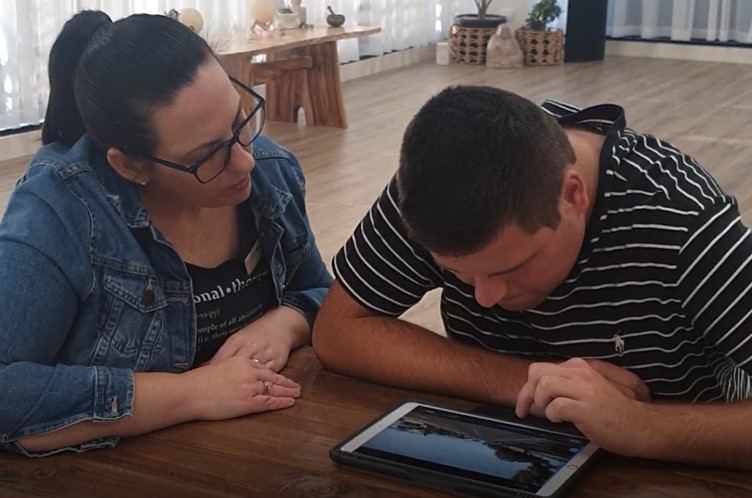
Find out if your teen is ready to learn to drive!
There is so much more to share… Jenny has developed a 1.5 hour pre-recorded webinar to guide you through the research in more detail, use a lifeskills review and walk you through what is involved in an OT “potential to drive” assessment.
Get the webinar here: https://drivingwell.thinkific.com/courses/is-my-young-adult-ready-for-driving
Use your NDIS funding
To purchase the webinar and toolkit through your young persons’ NDIS plan, send an email to admin@drivingwell.com.au, with your request, NDIS participant number and plan manager details.
Driving Well Occupational Therapy provides OT potential to drive assessment and driving therapy for learners and pre-learners in the Brisbane area and we love working with this group of young Australians on working toward their goal of becoming a driver.
Jenny Gribbin, Director / OT Driver Assessor, Driving Well Occupational Therapy
Learning to drive is an exciting rite of passage for young people. It can be the beginning of their life as a young adult, independence, trips with their friends – no more pick up and drops off for parents!
As exciting as it may be for the young person, it’s often a daunting prospect for parents.
- Are they ready?
- Will they be safe?
- How will I survive giving them lessons?
- What if they don’t pass?
Learning to drive requires a massive energy, time and monetary commitment. It takes time and practice to learn road law theory, courage to sit the exam (once or twice!) and even more courage to sit in the passenger seat as your child takes the wheel. Add to the mix, a learning disability, autism, ADHD, anxiety or physical impairment and it can seem an unclimbable mountain.
At Driving Well, we’re here to help you through this process.
Our Potential to Drive Program provides a starting point for learner drivers with additional needs who may be thinking of getting their learner’s permit or starting driving lessons. We provide comprehensive assessment to uncover the learner’s/your child’s learning needs based on their disability and work closely with specialised driving instructors to put together a learning package just for them.
We can also provide you with advice on what you can do in day-to-day life to build the skills they need to be a successful driver and support linking with formal therapies that may help. We also offer support for parents and caregivers to learn how to practice skills on-road skills with the individual and to learn the techniques used by their driving instructors to minimise lesson stress!
We can support you through the process of seeing if learning to drive can be supported by your NDIS Plan and walk you through the process form start to finish.
This is a huge undertaking and not a simple process. It is really important that we have a partnership between Driving Well OT and the client and their family.
Read more about the OT “potential to drive” process here.
Approval for driving training program
When a driving program (lessons) are recommended, the OT driver assessor will submit the OT driving assessment report and quote for the number of recommended lessons from the driving instructor provider, to the NDIA
“specialised driving training” is a quote required item, which needs to be approved by NDIA and added as a line item to your NDIA plan under Capacity Building: improved daily living (Specialised driver training 15_046_0129_1_3) this applies even if you have a goal regarding driving / community access, and even if you have sufficient budget in improved daily living.
Once you have written approval from the NDIA (and the line item is added to your NDIS plan), you are able to book your lessons directly with the driving instructor. (Note – as at February 2022, this is taking months to gain approval).
If you are with another insurer, a quote and report is provided, and the insurer must approve the quote to commence lessons.
Drive Focus App
Drive Focus is a tablet based app (ipad/android tablet) designed to develop visual search, reaction time/processing/decision and motor execution skills (the information processing model) required for driving.
- It has interactive video taken from the driver’s perspective, which is coded with tap-able “hotspots” of the critical items: brake lights, stop signs, traffic lights, speed signs, pedestrians, cars entering from left/right, objects on the road). The user must tap on the critical items as quickly as possible in the correct order.
- The app has Australian “tours” of Brisbane and Melbourne available and costs approximately $20AUD; there are seven drives within each tour, each of increasing difficulty.
- Visual cues for critical items can be turned on and off, and the videos can be slowed down to allow more processing time.
- The user’s score is presented at the end of each practice, and android users can email their results to their OT.
- A university study identified that six one-hour sessions of Drive Focus significantly reduce driving errors among already licenced drivers. The subjects also rated Drive Focus as valuable for improving their driving skills.
- There are other studies taking place in the USA and Canada presently to examine the efficacy of Drive Focus with populations including older adults post stroke, traumatic brain injury, and combat veterans with post-traumatic stress.
Our learner drivers are recommended to practice the app three to four times per week for about 15 minutes each session; they can level up through the drives, and review their score and re-attempt to improve their score (number of critical items and average response time).
The app is a Finalist for Best Assistive Technology product at the upcoming Australian Disability Service Awards, and winner of the Technology Award for Australian Road Safety Foundation 2021!
Why should I purchase the Get Driving toolkit?
Driving lessons are full-on – there is a lot to take in, especially in the early phases.
We know for conditions including ASD and ADHD that focusing on one task at a time and building this up (eg developing visual searching skills when outside of the car or when in the front passenger seat) will then make it easier to integrate skills when behind-the-wheel on driving lessons.
Driving Well has developed a therapy program (face to face clinic and passenger activities) and this online therapy toolkit for clients to purchase access at home with their parents / support workers, to work on fundamental skills needed for driving – and build these up so they will get more out of their driving lessons with the driving instructor.
Therapy program sessions at our new clinic space!
We are renting a clinic space at Takes Care Specialist Centre, 11 Cleveland St, Stones Corner on Wednesdays, commencing 16th November. We are so excited to be able to provide “Get Driving” therapy programs to our learner driver clients at this beautiful and accessible clinic space. This will reduce costs to our clients, and allow us to be so much more efficient in providing services.
Need support with driving and vehicle modifications assessments? Email admin@drivingwell.com.au to see if we can help you.
Article by Lauren Jackson OT Driver Assessor and Jenny Gribbin OT Driver Assessor
"*" indicates required fields
- Resources
- Insights
- Forms
- Driver Focus App
Driving Well Occupational Therapy is a busy practice that provides OT driving assessment and vehicle modification services for people with medical conditions and injuries in Brisbane, Ipswich and northern Gold Coast. We service clients who are self-funding, NDIS and other compensable (WorkCover, NIISQ, TAC, iCare).
On behalf of the team at Driving Well Occupational Therapy and in the spirit of reconciliation, I acknowledge the Traditional Custodians of Turrbul and Yuggera country, where our team live and serve the majority of our clients, as well as to all Traditional Custodians of country throughout Australia and their connections to the land, sea and community. I pay my respects to Elders past and present, and extend that respect to all First Nations people today.
On behalf of the team at Driving Well Occupational Therapy and in the spirit of reconciliation, I acknowledge the Traditional Custodians of Turrbul and Yuggera country, where our team live and serve the majority of our clients, as well as to all Traditional Custodians of country throughout Australia and their connections to the land, sea and community. I pay my respects to Elders past and present, and extend that respect to all First Nations people today.

